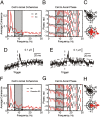Spinal interneuron circuits reduce approximately 10-Hz movement discontinuities by phase cancellation
- PMID: 20534484
- PMCID: PMC2890710
- DOI: 10.1073/pnas.0913373107
Spinal interneuron circuits reduce approximately 10-Hz movement discontinuities by phase cancellation
Abstract
Tremor imposes an important limit to the accuracy of fine movements in healthy individuals and can be a disabling feature of neurological disease. Voluntary slow finger movements are not smooth but are characterized by large discontinuities (i.e., steps) in the tremor frequency range (approximately 10 Hz). Previous studies have shown that these discontinuities are coherent with activity in the primary motor cortex (M1), but that other brain areas are probably also involved. We investigated the contribution of three important subcortical areas in two macaque monkeys trained to perform slow finger movements. Local field potential and single-unit activity were recorded from the deep cerebellar nuclei (DCN), medial pontomedullary reticular formation, and the intermediate zone of the spinal cord (SC). Coherence between LFP and acceleration was significant at 6 to 13 Hz for all areas, confirming the highly distributed nature of the central network responsible for this activity. The coherence phase at 6 to 13 Hz for DCN and pontomedullary reticular formation was similar to our previous results in M1. By contrast, for SC the phase differed from M1 by approximately pi rad. Examination of single-unit discharge confirmed that this was a genuine difference in neural spiking and could not be explained by different properties of the local field potential. Convergence of antiphase oscillations from the SC with cortical and subcortical descending inputs will lead to cancellation of approximately 10 Hz oscillations at the motoneuronal level. This could appreciably limit drive to muscle at this frequency, thereby reducing tremor and improving movement precision.
Conflict of interest statement
The authors declare no conflict of interest.
Figures




Similar articles
-
Coherence between motor cortical activity and peripheral discontinuities during slow finger movements.J Neurophysiol. 2009 Aug;102(2):1296-309. doi: 10.1152/jn.90996.2008. Epub 2009 May 27. J Neurophysiol. 2009. PMID: 19474171 Free PMC article.
-
Different phase delays of peripheral input to primate motor cortex and spinal cord promote cancellation at physiological tremor frequencies.J Neurophysiol. 2014 May;111(10):2001-16. doi: 10.1152/jn.00935.2012. Epub 2014 Feb 26. J Neurophysiol. 2014. PMID: 24572094 Free PMC article.
-
Different contributions of primary motor cortex, reticular formation, and spinal cord to fractionated muscle activation.J Neurophysiol. 2018 Jan 1;119(1):235-250. doi: 10.1152/jn.00672.2017. Epub 2017 Oct 18. J Neurophysiol. 2018. PMID: 29046427 Free PMC article.
-
Physiological and pathological oscillatory networks in the human motor system.J Physiol Paris. 2006 Jan;99(1):3-7. doi: 10.1016/j.jphysparis.2005.06.010. Epub 2005 Jul 27. J Physiol Paris. 2006. PMID: 16054347 Review.
-
Locomotor role of the corticoreticular-reticulospinal-spinal interneuronal system.Prog Brain Res. 2004;143:239-49. doi: 10.1016/S0079-6123(03)43024-0. Prog Brain Res. 2004. PMID: 14653169 Review.
Cited by
-
Spasms after spinal cord injury show low-frequency intermuscular coherence.J Neurophysiol. 2018 Oct 1;120(4):1765-1771. doi: 10.1152/jn.00112.2018. Epub 2018 Aug 1. J Neurophysiol. 2018. PMID: 30067124 Free PMC article.
-
Suppression of enhanced physiological tremor via stochastic noise: initial observations.PLoS One. 2014 Nov 14;9(11):e112782. doi: 10.1371/journal.pone.0112782. eCollection 2014. PLoS One. 2014. PMID: 25397577 Free PMC article. Clinical Trial.
-
The potential of corticomuscular and intermuscular coherence for research on human motor control.Front Hum Neurosci. 2013 Dec 10;7:855. doi: 10.3389/fnhum.2013.00855. eCollection 2013. Front Hum Neurosci. 2013. PMID: 24339813 Free PMC article. No abstract available.
-
Cerebellar nuclei neurons display aberrant oscillations during harmaline-induced tremor.Heliyon. 2021 Oct 4;7(10):e08119. doi: 10.1016/j.heliyon.2021.e08119. eCollection 2021 Oct. Heliyon. 2021. PMID: 34660929 Free PMC article.
-
Movement induced tremor in musicians and non-musicians reflects adaptive brain plasticity.Front Psychol. 2014 Jul 29;5:824. doi: 10.3389/fpsyg.2014.00824. eCollection 2014. Front Psychol. 2014. PMID: 25120522 Free PMC article.
References
-
- Baker SN, Pinches EM, Lemon RN. Synchronization in monkey motor cortex during a precision grip task. II. Effect of oscillatory activity on corticospinal output. J Neurophysiol. 2003;89:1941–1953. - PubMed
-
- Elble RJ, Randall JE. Motor-unit activity responsible for 8- to 12-Hz component of human physiological finger tremor. J Neurophysiol. 1976;39:370–383. - PubMed
-
- Murthy VN, Fetz EE. Oscillatory activity in sensorimotor cortex of awake monkeys: Synchronization of local field potentials and relation to behavior. J Neurophysiol. 1996;76:3949–3967. - PubMed
Publication types
MeSH terms
Grants and funding
LinkOut - more resources
Full Text Sources
Research Materials
Miscellaneous

